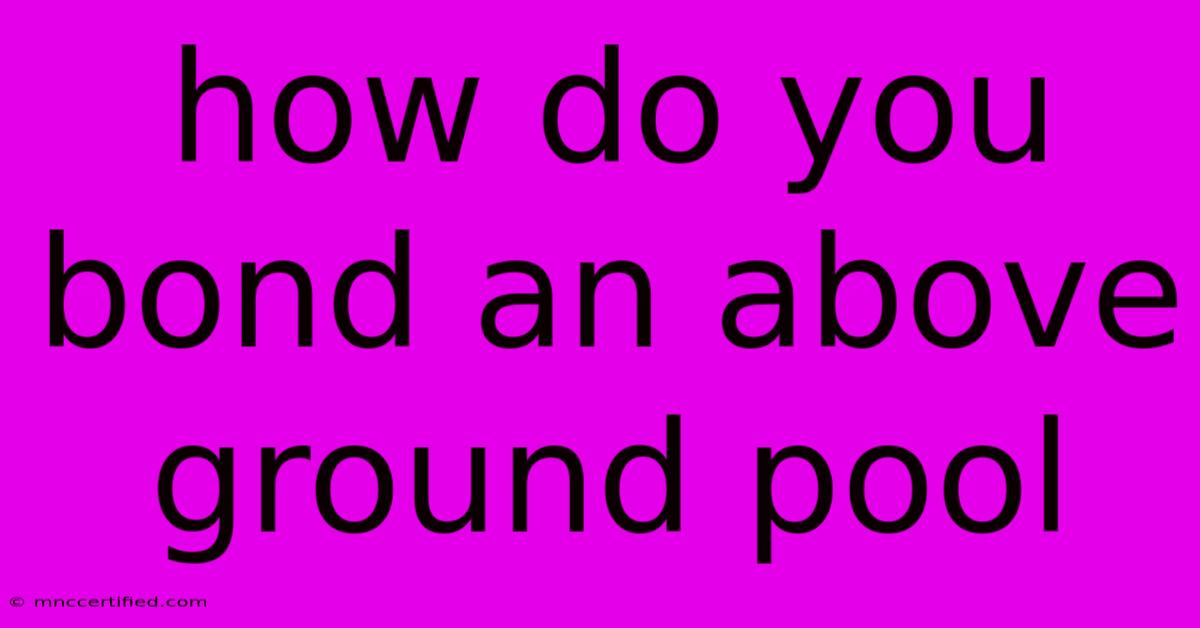How Do You Bond An Above Ground Pool

Table of Contents
How to Bond an Above Ground Pool: A Comprehensive Guide
Having an above ground pool is a fantastic way to enjoy the summer months, but it's crucial to ensure safety and prevent electrical accidents. Bonding your pool is an essential step in achieving this. This process involves connecting all metal components in the pool to the ground, providing a safe path for electricity to travel in case of a fault.
Let's dive into the details of why and how to bond your above ground pool.
Why is Bonding Important?
Electrical current always seeks the easiest path to ground. In a pool setting, this can be through the water and anyone in it. If a faulty wire or appliance comes into contact with the water, the current can flow through the person, causing serious injury or even death.
Pool bonding prevents this scenario by:
- Creating a low-resistance path: The bonding wire connects all metal parts, creating a path for the current to flow directly to the ground, bypassing the water and swimmers.
- Equalizing electrical potential: This ensures all metal components are at the same electrical potential, minimizing the risk of electrical shock from touching different parts.
What Components Need to be Bonded?
The following components are typically included in the pool bonding process:
- Pool ladder: Metal ladders provide a direct path to the water.
- Handrails: Handrails, especially if they are metal, should be bonded.
- Diving board: This is another potential point of contact with water and must be included in the bonding circuit.
- Pool lights: Metal housing for pool lights can conduct electricity.
- Pool skimmers: These typically have metal components.
- Metal rails: Metal rails around the pool deck should also be bonded.
- Metal fence: If your fence is metal, it should be connected to the bonding system.
- Metal equipment: This includes items like the pump, filter, heater, and any other metal components associated with the pool system.
How to Bond an Above Ground Pool: A Step-by-Step Guide
Before starting any electrical work, always disconnect the power supply to your pool equipment. It's also recommended to consult with a qualified electrician for advice and assistance if you're unsure about any aspect of the process.
1. Gather the necessary materials:
- Bonding wire: Use a #6 or #8 AWG (American Wire Gauge) copper wire, ideally with a green insulation color.
- Bonding clamps: These are used to connect the wire to the metal components.
- Ground rod: A copper-coated steel rod at least 10 feet long and 1/2 inch in diameter.
- Ground rod clamp: This connects the ground rod to the bonding wire.
- Wire cutters and strippers: For cutting and stripping the bonding wire.
- Voltage tester: For verifying the integrity of the bonding system after installation.
2. Install the ground rod:
- Find a suitable location: The ground rod should be driven into the ground at least 10 feet deep. Ideally, locate it near the electrical panel for your pool equipment.
- Drive the ground rod: Use a ground rod driver or a hammer to drive the rod into the ground until it's firmly anchored.
- Connect the ground rod clamp: Attach the ground rod clamp to the top of the ground rod.
3. Connect the bonding wire:
- Attach the wire to the ground rod: Connect the ground rod clamp to one end of the bonding wire.
- Run the wire to the first component: Follow a direct path, avoiding sharp bends and running the wire along the ground.
- Attach bonding clamps: Use bonding clamps to connect the bonding wire to all metal components in your pool. Make sure the clamps are secured tightly.
4. Connect to the pool equipment:
- Locate the electrical panel: The electrical panel for your pool equipment should have a grounding bar.
- Attach the bonding wire: Secure the other end of the bonding wire to the grounding bar within the electrical panel.
5. Test the bonding system:
- Reconnect the power supply: Once the bonding system is complete, turn the power back on to your pool equipment.
- Use a voltage tester: Measure the voltage between each metal component and the ground rod. All values should be less than 5 volts.
6. Maintain your bonding system:
- Inspect the bonding wire and clamps regularly: Ensure they are free from corrosion or damage.
- Retest the system annually: Use a voltage tester to confirm the bonding system is still working effectively.
Conclusion
Bonding your above ground pool is an essential safety measure that can help prevent serious electrical accidents. By following the steps outlined above, you can create a safe environment for your family and friends to enjoy your pool. Remember to consult a qualified electrician if you have any doubts or questions about the process.

Thank you for visiting our website wich cover about How Do You Bond An Above Ground Pool. We hope the information provided has been useful to you. Feel free to contact us if you have any questions or need further assistance. See you next time and dont miss to bookmark.
Featured Posts
-
How To Watch The 2024 Mtv Emas Live
Nov 11, 2024
-
Easy Jet Stock Where Will It Go In 2024
Nov 11, 2024
-
Mahomes Wife Shows Off Curls At Chiefs Game
Nov 11, 2024
-
Sheffield United Wins Steel City Derby In Efl
Nov 11, 2024
-
Vikings Defeat Jaguars 12 7 November 10th Recap
Nov 11, 2024